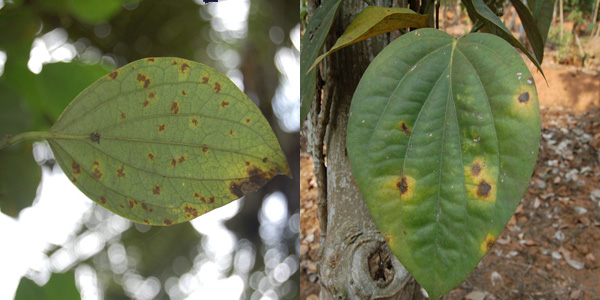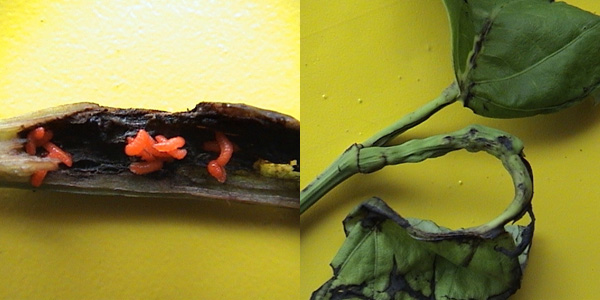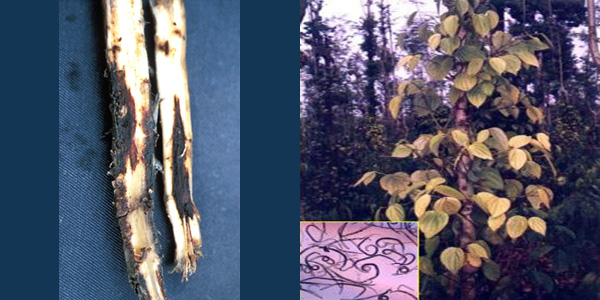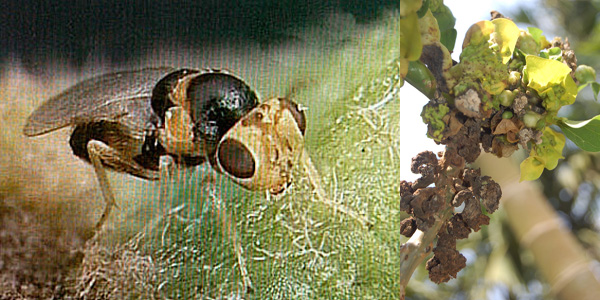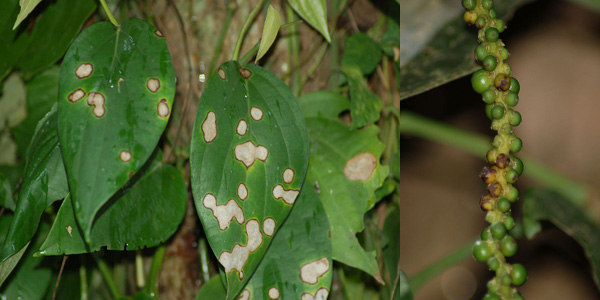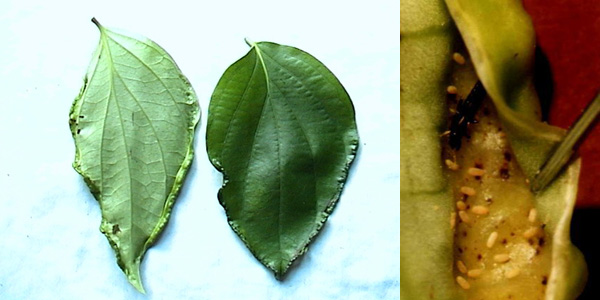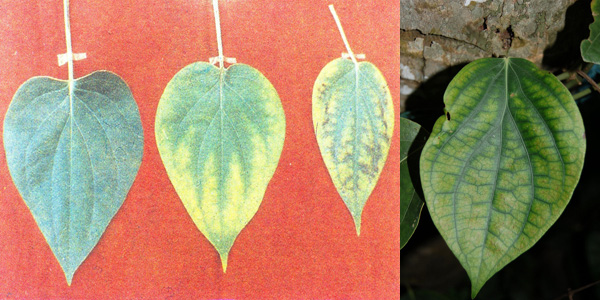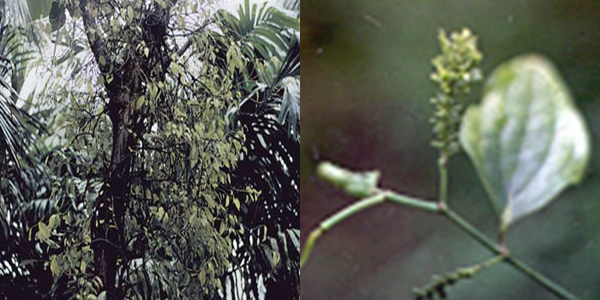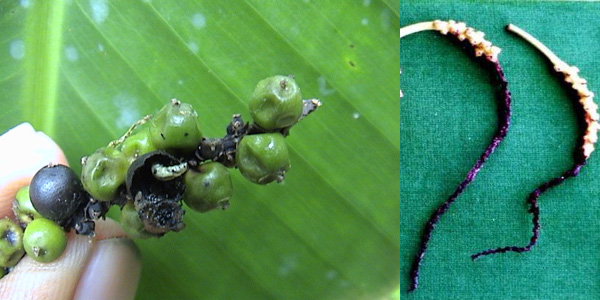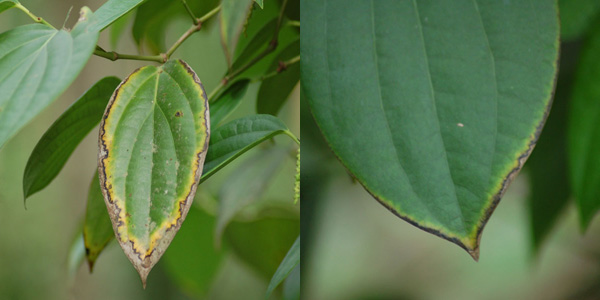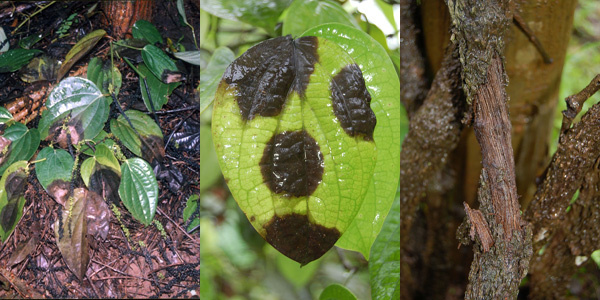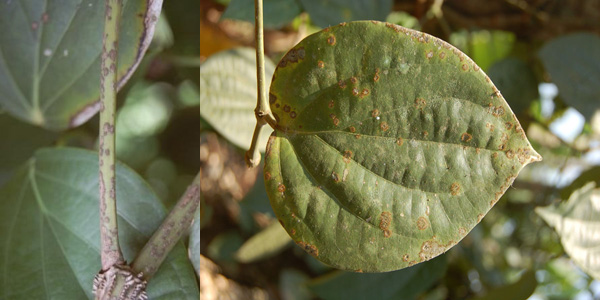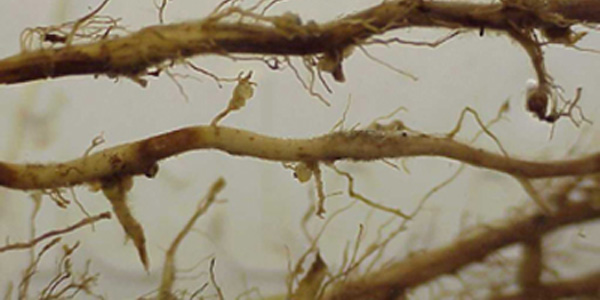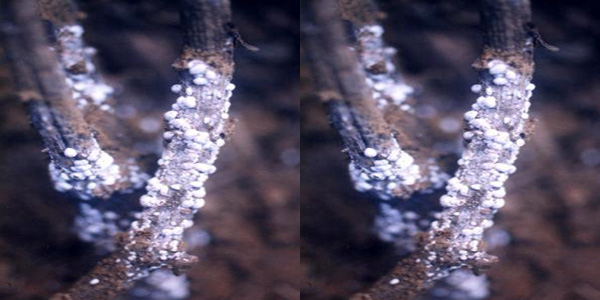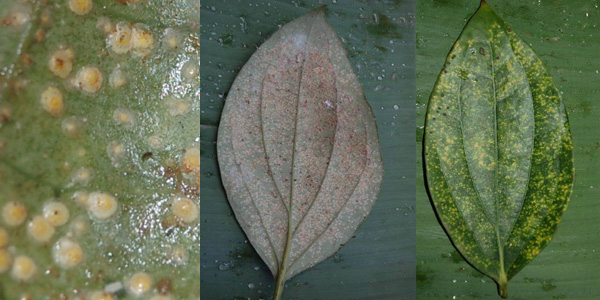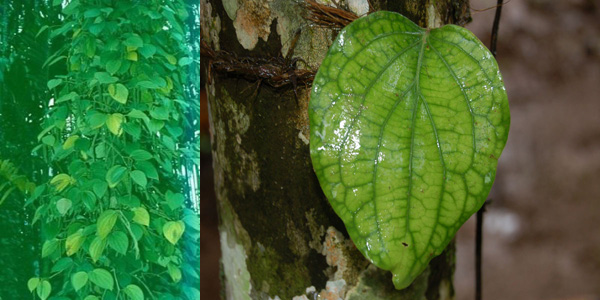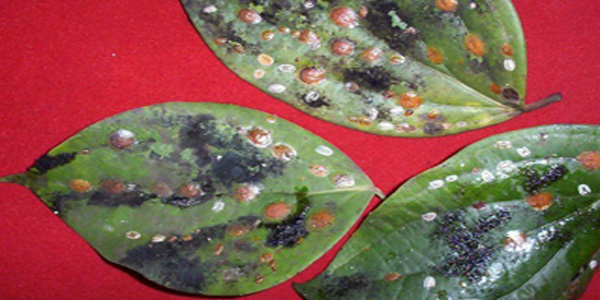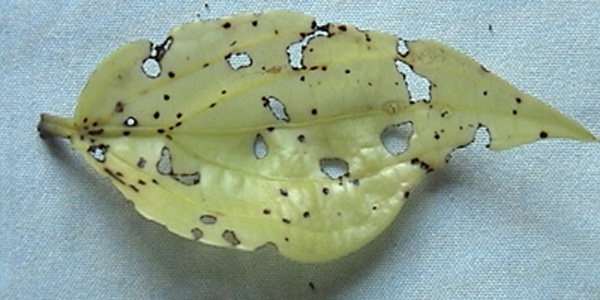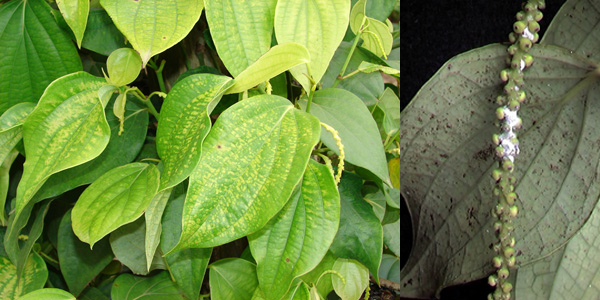|
Importance of the
problem |
Quick wilt is one of the most
destructive diseases of pepper prevalent in Kerala. The disease
causes sudden wilting, drying and death of black pepper vines.
The infection initiates with the onset of south-west monsoon.
And affects all cultivable varieties and vines of all age group.
Therefore, adopting a careful management strategy is very much
important in controlling the disease.
|
|
Common signs and
symptoms |
-
Infection starts as the formation of water soaked lesions,
changing to wet slimy dark patches on the collar region and
rotting as the disease progresses
-
Foot rot, the fatal symptom, is seen at the collar region
resulting in quick wilt
-
Vines with infected collar shows foliar yellowing, drooping
and flaccidity of leaves, defoliation, breaking of stem at the
nodal regions, withering and shriveling of berries and heavy
spike shedding without any discoloration
-
The collar infection spread upwards resulting into the rotting
of stem and downwards resulting into the rotting of the primary,
secondary and tertiary roots ultimately leading to death of
vines
-
Root infection also initiates as water soaked dark patches on
feeder, tertiary, secondary and primary roots resulting in root
decaying and shredding of roots
-
The foliar infection is noticed on leaves as water soaked
lesions and rapidly expands into large dark brown spots with fimbriate margin
-
The leaf infection is uniformly dark on young leaves or shows
concentric zonation with grayish centre on mature leaves
-
Foliar infection leads to varying degrees of defoliation
depending on the severity of the disease
-
The infected branches turn dark brown due to rotting
-
The infection on any part of the spike results in their
shedding
-
The infection on runner shoots and cuttings cause rotting of
sprouts resulting in shoot rot
|
|
Problems with similar
symptoms |
The symptoms are very much
characteristic of the problem and can be easily distinguished
from other problems.
|
|
Causal organism and
their spread |
The disease is caused by a fungus
called Phytophthora capsici. Heavy rainfall, more number of
rainy days, high relative humidity of more than 90%, low
temperature of 22-25 ºC and less sunshine hours are the
favorable climatic conditions for the disease. The secondary
inoculum, zoospores are responsible for the sudden outbreak of
the disease.
The disease spread is through soil, water, root contacts,
movement of people, slugs, snails, use of contaminated
implements etc. in a plantation. Intercultural operations
especially soil digging around the vine, nematode infestation,
root mealy bug attack etc. predispose the infection. The disease
spreads in centrifugal form from the source of infection. All
varieties and vines of all age groups are susceptible to this
disease
|
|
Mechanism of damage |
The oospores and chlamydospores
surviving in soil germinate with the receipt of monsoon showers
and initiate infection in roots and at collar region. The collar
and root infections are soil borne, lethal, results in heavy
crop loss and completely destroys the vines whereas the foliar
infection results in heavy spike shedding and defoliation.
|
|
Ideal management
strategy |
For an
effective management of the disease, early detection of the disease
and timely plant protection measures are important. The following
integrated disease management practices involving cultural,
biological and chemical methods should be adopted for the control of
this disease
Phytosanitation
• Remove and burn all infected plant debris and dead vines along
with root system to reduce the build up of the inoculum in the
field. Further, drench such spots with 0.2% copper oxy-chloride
(2g/L) or 1% Bordeaux mixture to eradicate the inoculum from the
soil
• Plant disease free rooted cuttings and raise nurseries using
disease free planting material
Cultural Practices
• With the onset of the monsoon, lop the branches of the supporting
standards and shade trees to ensure penetration of sunlight and
avoid build up of humidity
• Prune the runner shoots or tie back to vines before the onset of
monsoon
• Prune off the leaves and shoots of vines to a height of 2 feet
from the soil
• To avoid soil splash and consequent disease initiation and spread,
establish a legume cover in the plantation or cover the basin with
thick dried leaf mulch
• Wherever water stagnation is a problem, ensure effective drainage
of both surface and sub-soil. Earth up soil around the collar region
of the vine to avoid water stagnation and reduce collar infection.
• Keep soil digging operations to the minimum during monsoon season
to avoid injury to the root system and follow minimum tillage
concept
• Apply balanced and recommended dose of manures and fertilizers
• Apply 1 kg of lime and 2 kg of neem cake per standard per year as
pre-monsoon dose. Apply neem cake one month after lime application.
• Avoid frequent movement of personnel and animals from diseased
gardens to healthy gardens
Biological Control
• Biological control of this disease is very well established under
the field condition and many farmers are successfully following this
practice to combat the disease
• Inoculate the pepper vines with native isolates of VAM,
Trichoderma harzianum or / and Pseudomonas fluorescens at the time
of planting in the nursery and main field. In the established
plantations apply during pre-monsoon and post monsoon period
Sl. No. Bio-Control Agent Method of Application
1 Trichoderma harzianum Apply in soil around the vines and cuttings;
Mass multiply in organic amendments viz. dried FYM, compost,
vermin-compost, coir pith compost, neem cake, decomposed coffee husk
etc. and apply @ 5-10 kg/vine/year.
2 Pseudomonas fluorescens Drench soil around the vines and cuttings;
Spray nursery and main field with 2% of commercial formulation
(20g/L)
3 VAM Inoculate cuttings at the time of planting in the nursery and
main field
• Prophylactic application of bio-control agents will give better
control of disease. It will not be of any use if applied after the
initiation of the disease
Chemical Control
• As prophylactic measure, drench all the vines to a radius of 50 cm
(5-10 litre) and give foliar spray with 0.2% copper oxychloride
(2g/L) or 1% Bordeaux mixture immediately after the receipt of
south-west monsoon showers (May-June), just before the onset of
north-east monsoon (Aug-Sept) and during October-November if the
monsoon is prolonged
• Apply Bordeaux paste at the collar region of vines (upto 50 cm
height). The above two prophylactic measures will give enough
protection to the crop against this disease
• During the initial phase of infection, drench the vines with 0.2 %
Potassium/Sodium Phosphonate (Akomin or phosjet @ 4-5 ml/l) and
spray with 0.1 to 0.15% Potassium/ Sodium Phosphonate (Akomin or
phosjet @ 3-4ml/L) which is compatible with biocontrol agents. Do
not use copper fungicides if the garden is protected with biocontrol
agents
• Ridomil MZ / Matco (Metalaxyl + Mancozeb) @ 2g / L or Aliette (Fosetyl-Al)
@ 2 g /L can also be used for both spraying and soil drenching in
diseased gardens
• While spraying, take care to add stickers at the rate of 0.5 ml/L
of fungicide solution
• Effectively contain the disease by eradicating all the dead and
infected vines through campaign and participatory approach.
Rejuvenate plantation if the infection is less than 50 % with the
above described measures. Undertake total replanting where the
mortality is more than 50%. Take up gap filling or replanting only
after a period of one year. At the time of replanting, drench soil
with 1 % Bordeaux mixture or 0.2 % copper oxychloride (2g/L).
Understand the gravity of the problem and take all possible control
measures in ward/Panchayat/Block/District level at the right time
with the help of farmers, officials of Agricultural Department,
Kerala Agricultural University and Indian Institute of Spices
Research and peoples representatives |
|
References |
1. KAU (2002) Package of Practices
Recommendations: Crops, Kerala Agricultural University, Vellanikkara.
2. KAU (2008) Crop Health Decision Support System (CD), Kerala
Agricultural University, Vellanikkara. |
